The women singer-songwriters of the 60s and 70s: the music, the men, & the moxy
Were they connected with one another? And how?
This is the fifth in a series of posts about women singer-songwriters of the late sixties and seventies.
So far we’ve covered “You’re So Vain” by Carly Simon, “Both Sides Now” by Judy Collins, “Help Me” by Joni Mitchell, and “Diamonds and Rust” by Joan Baez.
Today I’m taking a detour to look at the relationships among these singer-songwriters. Of course they knew about one another, but did they actually know one another? And, if so, in what way?
I think what I found will surprise you as much as it has me.
If you haven’t read the posts about Carly, Judy, Joni, and Joan yet, you might want to do that first for context. But I will link to them again as we roll along, so you’ll also have the opportunity to read them as part of the overall story.
Back in the day
The question is, did Carole King, Carly Simon, Judy Collins, Joni Mitchell, or Joan Baez cross paths? And if so, what happened?
Did they like one another, or were they competitive?
It also begs the question, just how interconnected, or even incestuous, was the rock, pop, and folk community at that time?
I wouldn’t have thought to ask all of this, but I ran across some information that was so surprising and juicy, I decided I must share it with you. There are some interesting and downright ‘entertaining’ connections between these singer-songwriters.
I believe that the nature and longevity of such connections has much to tell us about both creativity and friendship. But you be the judge.
The three J’s — Joan, Judy, and Joni — and CSN&Y
Joan Baez and Judy Collins both became folk singers in New England (Boston and Connecticut respectively) around the same time and released their first albums at the beginning of the sixties — Joan’s self-titled album in 1960 and Judy’s A Maid of Constant Sorrow in 1961. Instead of rivals, as you might expect, they became close friends, with Judy singing at Joan’s wedding to David Harris in 1968. Judy was also close friends with Richard Fariña, who married Joan’s sister Mimi, and the Fariñas often stayed with Judy in New York.
You already know the humorous story of how Joni met Judy through Al Kooper from my post on Joni Mitchell. (If you haven’t, go read it and come back!) As a result, Judy used her power as a Board member to get the unknown Joni a slot at the Newport Folk Festival, and Judy covered two of Joni’s songs on her album Wildflowers, with “Both Sides Now” giving Judy a top ten hit and a Grammy award (as covered in my post on Judy). Of course, Joan was performing at the festival as well, providing the opportunity for Joni to get to know another folk music powerhouse and role model for success.
It’s worth mentioning that 42 years later, in 2009, Joan and Judy would perform Joan’s hit “Diamonds and Rust” (see my post about Joan) at the Newport Folk Festival. Their gorgeous acoustic duet is a must-watch:
Joan was influential not only at the Newport Folk Festival, but also as the co-founder and host of the annual Big Sur Folk Festival, sponsored by the Esalen Institute in California from 1964 to 1971. As would be expected, Judy was one of the guest performers for three years running (1966 to 1968), and, once she’d met Joan and Judy in 1967, Joni would attend the following year (photo below) and perform the year after. Linda Ronstadt, another singer-songwriter we will cover, would perform there in 1970.
You can see Stephen Stills in the background of the photo above. What you may not know is that Judy and Joni would have a dramatic impact on Crosby, Stills & Nash and then CSN&Y (‘Y’ being the addition of Neil Young), as the inspiration for two of their biggest hits.
First was Judy’s inspiration vis-à-vis CS&N. Stephen had been in a two-year relationship with Judy and was sad about their impending breakup when he penned the song “Suite: Judy Blue Eyes.” The group included it on their self-titled debut album and it went to #21 on the Billboard Hot 100. “You Don’t Have to Cry” on the same album was purportedly also about their relationship. With another Top 40 single in “Marrakesh Express,” the album went quadruple platinum and the group won a Grammy for Best New Artist.
Joni, on the other hand, would actually write supergroup Crosby, Stills, Nash & Young’s biggest debut hit single. On August 17, 1969, Joni opened for Crosby, Stills & Nash (with Neil Young) at their first gig in Chicago, and flew with them to New York to appear at the Woodstock Festival the next day. However, her manager Elliott Roberts and agent David Geffen had arranged for her to appear on The Dick Cavett Show the following night and talked her out of performing at Woodstock given their concerns about safety and traffic.
Instead, Joni watched on TV as CS&N (plus Y for part of it) performed 16 songs, starting with their hit single inspired by Judy, “Suite: Judy Blue Eyes.” (Not to mention that Joan Baez performed 14 songs at Woodstock, which Joni may have watched as well.) Joni then memorialized her impressions of the festival in the song “Woodstock,” which she performed on her Ladies of the Canyon album (April 1970) and which CSN&Y would cover on their debut album Déjà Vu (March 1970) and take to #11 on the Billboard Hot 100.
The song has since become synonymous with the Woodstock Festival, an anthem of sorts. I recommend checking out CSN&Y’s superb cover, but you must watch this 1970 video of Joni singing on the BBC if you want a front-row seat to her unique and extraordinary talent:
Carole, Joni, and James Taylor
In 1968, Joni bought a home in Laurel Canyon, an area in the Hollywood Hills section of Los Angeles popular with musicians. She lived close to Carole King but the two did not yet know one another. Three years later, they would become well-acquainted both personally and musically, courtesy of one James Vernon Taylor (also known as JT).
By January 1971, Carole had already played and sung on James’ album Sweet Baby James and joined him on tour. It was while touring with him that she had written the song “So Far Away” about missing her family, which would become one of the songs on her album Tapestry, then being recorded in Studio B of A&M Recording Studios in Hollywood.
Carole wrote all of the songs for the album, but struggled with the lyrics for two of them — “It’s Too Late” and “Where You Lead” — and asked for help from her friend and collaborator, lyricist Toni Stern (below with Carole). The monster hit for the album would turn out to be the break-up song “It’s Too Late,” and Toni wouldn’t reveal who the lyrics were about, but James Taylor had recently ended his love affair with her to take up with none other than Joni Mitchell.
James got Carole’s permission to cover one of her new songs, “You’ve Got a Friend,” for his upcoming album Mud Slide Slim and the Blue Horizon (1971). His cover would score him the only #1 hit single of his career and push the album to #2 on the Billboard charts. The backup vocals on that song, as well as on two other tracks, were provided by his new girlfriend, Joni Mitchell.
James and Carole were recording their albums at the same time, using many of the same musicians, with Carole playing piano on seven of his songs and James playing acoustic guitar and backup vocals on some of her songs.
In the studio right next to Carol’s, Joni was also recording an album, what would become her critically and commercially successful fourth studio album, Blue. James played acoustic guitar on four tracks.
James and Joni also sang backup on Carole’s “Will You Love Me Tomorrow,” which became a staple of Carole’s shows and a popular duet on James and Carole’s international Troubadour Reunion Tour in 2010.
In a small window of time, January to February 1971, three landmark albums emerged from these artists. Not to mention, Russ Kunkel drummed on all of them. Magic in a bottle. There are some key lessons here, no doubt. For help in pondering further, you might enjoy (re)visiting my posts on James Taylor as a Creator and Carole King as a Creator in which they talk about their creative processes.
Let’s listen to one of my favorite songs of all time — this song always gets me — Carole’s “It’s Too Late,” performed by Carole on the BBC the very day that Tapestry came out, accompanied by her friend and guitarist on the album, Danny “Kootch” Kortchmar:
Carly, JT, and Joni, with a sprinkling of Linda
Carly Simon was one of only two student folk singers during her time as an undergraduate at the women-only Sarah Lawrence College, a time when she became aware of and admired Judy Collins’ recent album release, A Maid of Constant Sorrow. Later, when Carly performed for about six months with the group Elephant’s Memory, she sent some of her songs to artists she thought might want to record them, including Judy Collins, Burt Bacharach, and Dionne Warwick, without success.
In an ironic twist of fate, the very same music executive who discovered and signed Judy in the early sixties, and who supervised Judy’s hit cover of Joni’s “Both Sides Now” in 1967, would also sign Carly as a solo artist in 1970. (Carly had been signed before, to Kapp Records in the early 60s with her sister Lucy as the Simon Sisters.) That executive, Jac Holzman, the founder and CEO of Elektra Records, believed that he’d found a hit after hearing Carly’s demo of “That’s the Way I’ve Always Heard It Should Be.”
Carly’s self-titled debut album came out exactly one day before Carole’s Tapestry, February 9, 1971, and would have the Top 10 hit that Jac predicted, as well as place #30 on the Billboard album chart for the year and give Carly a Grammy as Best New Artist.
Although Carly suffered from stagefright, she gave a pitch-perfect performance of her hit song in front of a who’s who of rock nobility at the Schaefer Music Festival in Central Park in July 1971, which was later broadcast as Good Vibrations from Central Park on ABC-TV — with some amusing shots of George Harrison and Art Garfunkel having a tête-à-tête before she gets underway:
Carly’s ostensible overnight success (although she’d been performing for ten years) garnered her the attention of many famous and powerful men — see my post on her hit to come “You’re So Vain” — including James Taylor, whom she fell in love with and married in November 1972. They remained married until 1983.
[Interesting sidenote: Who did Carly then get engaged to from 1985-86 but none other than Russ Kunkel (!), the drummer on Carole’s, Joni’s, and James’ albums in 1971, who played with her on her 1985 album Spoiled Girl.]
After Carly and James started living together (but before they got married), James told Joni Mitchell not to call him anymore, even though they were no longer involved with one another, which “hurt” Joni’s feelings. Right after getting married, Carly took it upon herself to ask friend and manager Arlyne Rothberg to arrange a lunch with Joni at Mr. Chow’s in L.A. to make peace.
Arlyne arranged the lunch and decided to invite Linda Ronstadt (below) to ease the tension. As reported in Girls Like Us by Sheila Weller, “Carly and Joni were so wary of each other that they barely lifted their forks and mediator Arlyne didn’t either, out of anxiety about the situation. ‘Linda,’ Arlyne says, ‘was the only one of us who ate. She ate everybody’s lunch!’”
It took another 24 years, but Carly and Joni finally had dinner with one another and Joni was surprised at “‘what a great person she was’.” The two of them would continue to meet up, get to know one another, and become friends.
And the tension-relieving Linda who ate everyone’s lunch at Mr. Chow’s? She’s next up in this women singer-songwriter series, with a focus on one of her biggest hits and more about her own extensive music industry connections.




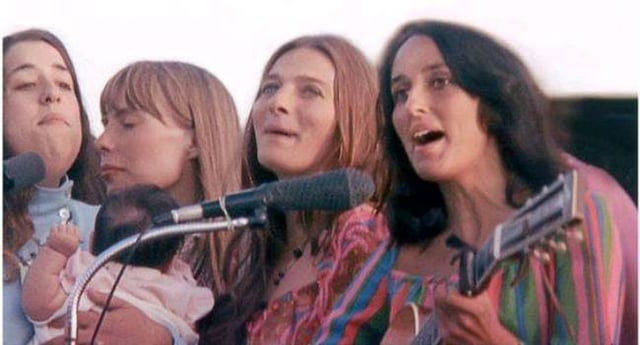

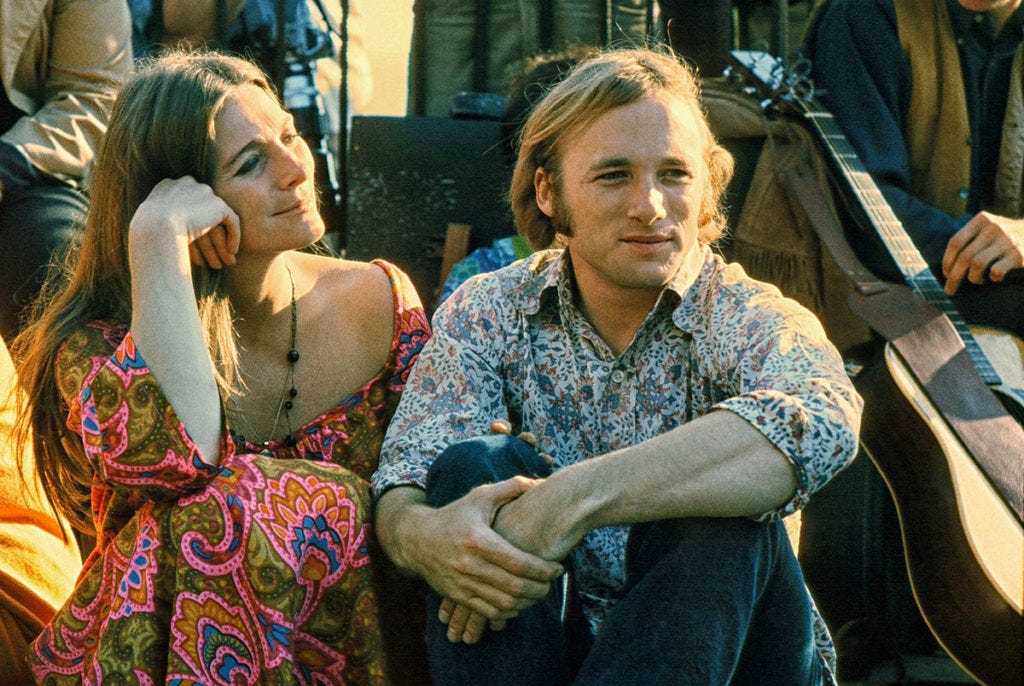
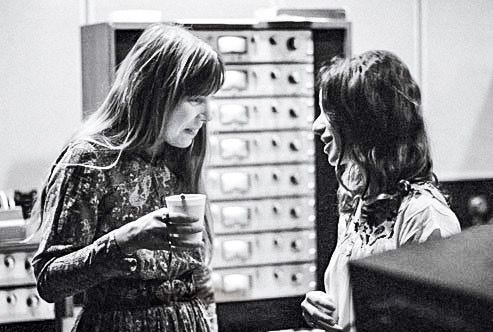
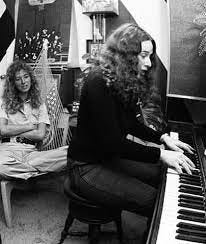
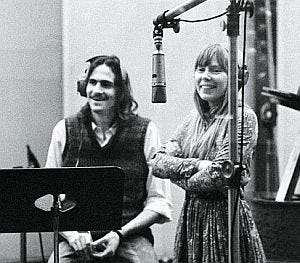

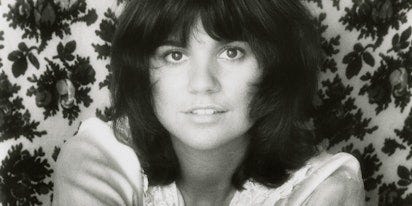
Love it! I love the three C's of the 70s: Carole, Carly, & the Carpenters! Ok, I know the third doesn't really count but as half of the brother/sister duo, Karen Carpenter had THE emotional voice of the era. Her interpretations of songs came from the heart and the gut. She also DID sing one of Carole's songs: "It's Going to Take Some time." Would have loved to hear her sing some Carly (or Joni, Joan, or Judy!)
So well-written, Ellen! I loved the points of reference. I had no idea just how close together those landmark albums had been released! And, I'm not sure I was aware of quite the amount of "cross-pollination" of the players on each album!
Such a great choice of videos, too, highlighting the three ladies (all known for their guitar-playing from one song or era to another) but, here, all sitting at the piano!
What strikes me, too, is trying to hear these songs as they must've been heard, for their first times back then. Like, kudos to Jac Holzman for hearing a hit in Carly's song! Easy to hear it in retrospect after the hundreds of times we've all heard it over the decades, but what a generally "non-standard" sounding song to make a call on that as a hit on first hearing! But, that's why he was the exec!
And, at the piano for their songs, Carole and Joni....such wildly different talents! Joni and her jazz-influenced touches, and, at times, melody structure (I've always called Joni the west coast Laura Nyro!), and Carole, with her "proper" pop songwriting style with her Brill Bldg pedigree!
Really tremendous.....thanks, Ellen!